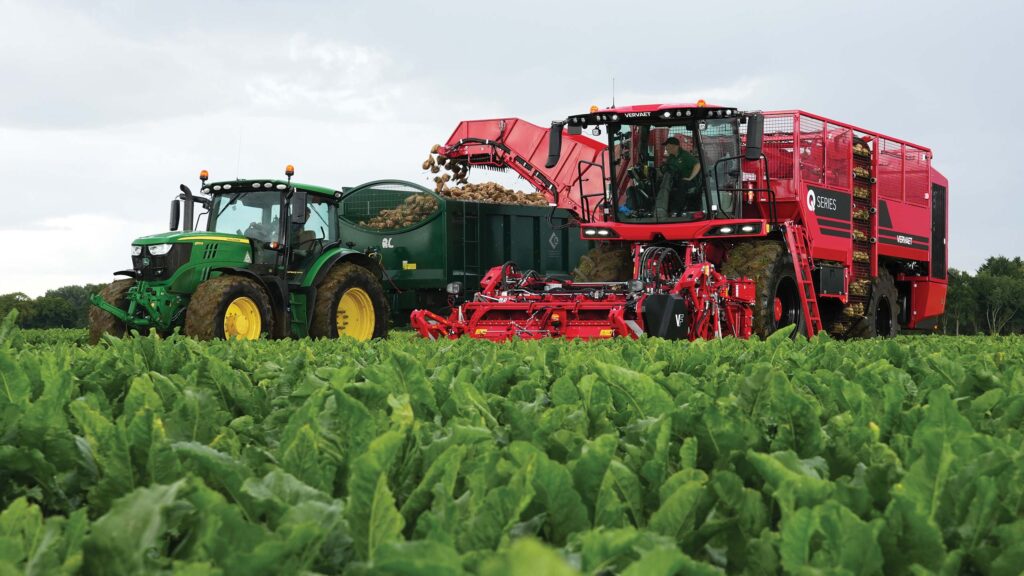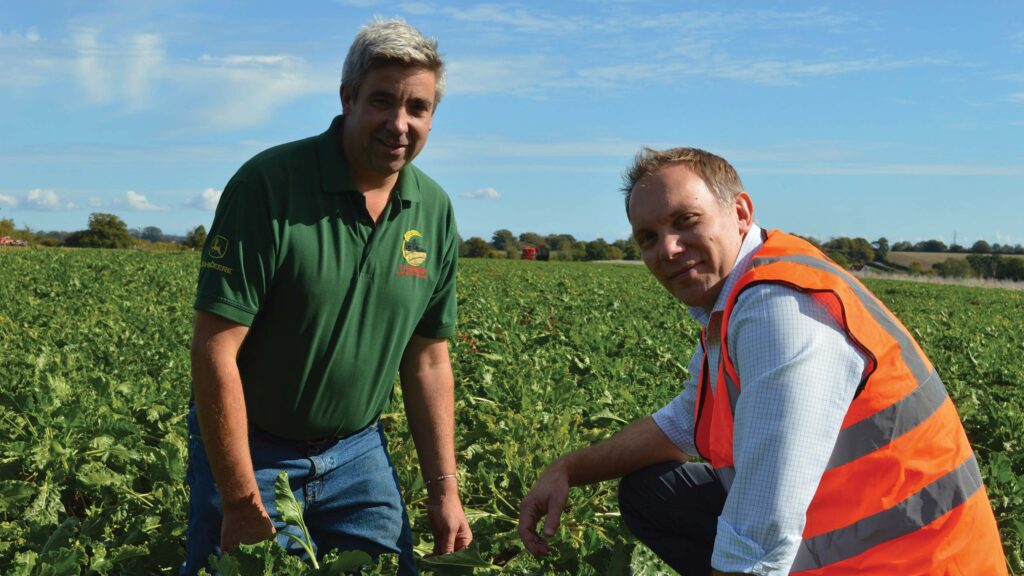Early sugar beet yields look good despite dry season
 © Anglian Agri Media Ltd
© Anglian Agri Media Ltd Suffolk sugar beet grower and contractor Peter Steward has been pleasantly surprised by the successful start to his sugar beet harvest, despite seven months of below-average rainfall.
Peter’s two Vervaet 6-row harvesters are running flat out, and he has lifted more than 20% of the 2,400ha he is contracted to lift.
Early crops were headed for British Sugar’s Wissington factory before his local Bury St Edmunds plant opened at the end of September.
See also: Farmers reveal results of biological inputs trial
“We’re seeing yields of 71-89.6t/ha so far,” says Peter. “Sugar levels are coming in at 17.3% at Bury St Edmunds, which is well above average for this point in the season, where we usually expect to hit 16-17% sugar content.”
Peter grows 170ha of sugar beet on his own farm and contracted land, and was initially cautious about yields after early root digs, and was not expecting such high yields so early in the harvest.
“Our poorest field from the harvester, which I thought would hit the low 60s, came in at a surprising 71t/ha,” he adds.
Last season, about 2,300 growers harvested 7.7m tonnes of beet, giving an average nationwide yield across British Sugar’s four factory areas of 73.2t/ha.
Factors contributing to the strong early performance, Peter says, were the soil conditions and the timing of drilling, as the seed went into moisture, the ground was quickly rolled and the crop came through well.
Early drilling
This season he started drilling earlier than usual on 14 March, and the good early establishment appears to have made a big difference to his yields.
Lifting on a contract farm just east of Stowmarket, he estimates his current yields at 75-80t/ha on medium clay loam soil.
This is despite below-normal rainfall every month since February – with only 3mm of rain in March followed by a very dry April and May.
“The crops are far exceeding our expectations, and we are very happy considering the dry season. It shows that once beet gets away it is a very resilient crop,” he says.
Peter aims to preserve soil moisture using just a disc and tine Vaderstad TopDown cultivator in the autumn, and then a light tine cultivation in the spring.
His residual herbicides were hampered by the dry spring so he had to undertake some hoeing.
Like many sugar beet crops this season, aphid pressure was generally very low, so he sprayed only one field with a foliar insecticide to protect against virus yellows.
“Virus yellows hasn’t been a serious issue at all,” he adds.
Peter is still committed to the crop due to its array of benefits.
This is despite the beet price set to fall by 9% next year to a one-year fixed price of £30/t for up to 65% of the beet contract, from this season’s £33/t for 70% of the contract.
“We’re actually taking on more land for sugar beet next year. It’s still our most profitable and beneficial break crop. It’s resilient and it gives a really good entry into cereals,” he says.
However, he does think that some sugar beet growers will reduce the area of their crop next year following the price reduction, and is expecting to see a fall in the area he is contracted to harvest in 2026.

Peter Steward (left) with Dan Green of British Sugar © David Jones
Industry overview
Dan Green, agriculture director at British Sugar, has also been encouraged with the early yields seen so far this season as its four processing factories start up.
“We’ve got a wide range of yields coming in nationally from 75t/ha to 90t/ha so far, and one contract at Bury has already finished at 90t/ha, which is incredible,” says Dan.
While crops on lighter soils are struggling in the dry conditions, they still have time to develop through the autumn while lifting focuses on the heavier land.
“We’re hopeful that the recent good lifting conditions will continue, enabling our factories to run as efficiently as possible over the coming months.
“We anticipate an average-sized crop this year or just above average, but a lot will depend on sugar contents,” he adds.
British Sugar has continued to develop its existing Lifted and Delivered apps, which are designed to improve logistics and crop data for all across the beet supply chain.
“For the first time in our history, we now have visibility of our whole beet supply chain, from field to factory,” says Dan.
“The app provides real-time visibility of beet movements, navigation systems and safety features. It’s a huge step forward in improving the campaign for everyone.”
Peter is particularly impressed with one feature of the new app. “The overhead powerline visibility is absolutely brilliant, especially when we’re harvesting at night. It’s a huge step forward in safety.”
The future of prices
The sugar beet headline price for the 2026 crop at £30/t is causing concern for some growers, and there is a fear that the area of the 2026 crop will decline from the 95,000ha drilled in spring 2025.
As recently as 2023 the beet price was as high as £40/t.
The fall in contract price reflects the fall in European sugar prices over the past 12 months, says British Sugar, but Dan points out that the crop still has a wide range of benefits.
“It’s resilient, and a great spring break crop, providing a clean and profitable entry into winter wheat,” he says.
British Sugar is supporting growers through this challenging period by offering several contract options.
These include a market-linked bonus for a share of the upside when the market is favourable, an index-linked contract for those with a greater appetite for risk and reward, a cash advance scheme, and yield protection insurance for growers concerned by virus yellows and adverse weather.
This year, a contract “holiday” has been offered for those wanting to take a year off.
Despite the pricing pressure, British Sugar is still confident in the long-term role of sugar beet in UK arable farming.
“Even with the dry summer, yields are holding up, and it fits very well into rotations. Yes, there’s price volatility, but that’s a challenge for all crops right now.
“The beet price reflects where the sugar price is, and remember the sugar market is cyclical,” says Dan.
British Sugar’s parent company, Associated British Foods, has warned its operating profits from its sugar operations is expected to be only close to breakeven for its financial year to mid-September 2025.
It blames low European sugar prices and the high cost of beet.
AB Foods has sugar processing operations in the UK, Spain and Africa, but does not split out separately the profits from its UK business British Sugar.
UK sugar beet production |
||||
| Year | Area | Beet production | Yield | Sugar production |
| 2023 | 99,000ha | 8m tonnes | 79.4t/ha | 1.1m tonnes |
| 2024 | 102,500ha | 7.7m tonnes | 73.2t/ha | 1.1m tonnes |
| 2025 | 95,000ha | |||
Virus yellows
This season was the first for a number of years when neonicotinoid insecticide seed dressings were not available for use to control virus yellows.
The disease can lead to yield losses up of 50% in sugar beet.
In recent years, emergency use, or derogation, allowed the seed dressings, but this season growers had to rely on three insecticide products which can be applied to the growing crops.
The virus is transmitted largely by the peach potato aphid (Myzus persicae), causing circular yellow patches to appear in sugar beet crops between June and August.
The incidence of the disease was expected to be low this year, due largely to the cold winter which helped control aphid numbers.
The three insecticide products approved for use all have different modes of action, and include InSyst (acetamiprid), Teppeki/Afinto (flonicamid) and Sivanto Prime (flupryradifurone).

